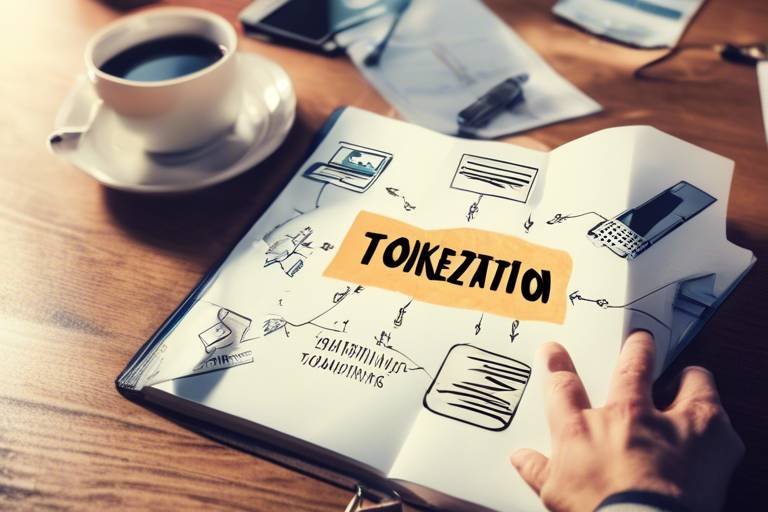The Role of Blockchain in Real-Time Supply Chain Monitoring
In today's fast-paced world, the need for real-time insights into supply chain operations has never been more critical. Imagine a scenario where you can track the journey of a product from its origin to your doorstep, all while ensuring its authenticity and quality. This is where blockchain technology comes into play, revolutionizing the way we monitor supply chains. With its unique ability to provide a decentralized and secure ledger, blockchain enhances transparency, efficiency, and security in supply chain management.
At its core, blockchain serves as a digital ledger that records transactions across multiple computers, making it virtually impossible to alter or tamper with the data. This decentralized nature not only fosters trust among stakeholders but also ensures that everyone involved in the supply chain has access to the same information in real-time. So, whether you are a manufacturer, distributor, or consumer, you can have peace of mind knowing that you are part of a transparent system.
The benefits of implementing blockchain for real-time monitoring are immense. For starters, it allows for improved decision-making. With access to real-time data, businesses can make informed choices quickly, responding to disruptions or changes in demand with agility. Furthermore, enhanced traceability means that if a product is found to be defective or contaminated, companies can swiftly identify the source and take corrective action. This not only saves time but also protects the brand's reputation.
Moreover, the secure nature of blockchain significantly reduces fraud in supply chains. By verifying each transaction, stakeholders can ensure that the products they receive are genuine and not counterfeit. This is particularly crucial in industries like pharmaceuticals, where the integrity of the supply chain can directly impact consumer safety.
However, it's important to recognize that implementing blockchain is not without its challenges. Companies may face technological barriers, such as the need for advanced infrastructure or skilled personnel. Additionally, there can be resistance to change from stakeholders who are accustomed to traditional methods. To overcome these hurdles, a concerted effort towards developing industry-wide standards and educating all parties involved is essential.
As we look to the future, the potential for blockchain in supply chain management is vast. Innovations in technology could further enhance real-time monitoring capabilities, paving the way for a more integrated and efficient supply chain ecosystem. The question remains: how will industries adapt to harness the full power of blockchain?
- What is blockchain technology?
Blockchain is a decentralized digital ledger that records transactions across multiple computers, ensuring data integrity and security. - How does blockchain improve supply chain transparency?
It provides an immutable record of transactions, allowing all stakeholders to access real-time data and verify product authenticity. - What are the main benefits of real-time supply chain monitoring?
Benefits include improved decision-making, enhanced traceability, and reduced fraud. - What challenges exist in implementing blockchain in supply chains?
Challenges include technological barriers, resistance to change, and the need for industry-wide standards. - How can companies overcome these challenges?
By developing industry standards and providing education to stakeholders on the benefits of blockchain.

Understanding Blockchain Technology
Blockchain technology is often hailed as a revolutionary force in the digital landscape, and for good reason. At its core, blockchain is a decentralized digital ledger that records transactions across multiple computers in such a way that the registered transactions cannot be altered retroactively. This creates a secure and transparent environment where data integrity is paramount. Imagine a giant digital notebook that everyone can see but no one can erase; that’s blockchain in a nutshell.
One of the most compelling aspects of blockchain is its security features. Each transaction is encrypted and linked to the previous transaction, forming a chain of blocks. This means that altering any single block would require changing all subsequent blocks, an almost impossible feat without the consensus of the network. This inherent security makes blockchain particularly well-suited for tracking and verifying supply chain activities in real-time.
Moreover, blockchain operates on a consensus mechanism, which means that all participants in the network must agree on the validity of transactions before they are recorded. This reduces the risk of fraud and ensures that all parties have access to the same information. In the context of supply chains, this is a game-changer. Stakeholders, from manufacturers to consumers, can track the movement of goods and verify their authenticity without relying on a central authority.
To illustrate the workings of blockchain, consider the following table that highlights its key components:
| Component | Description |
|---|---|
| Blocks | Data structures that hold transaction information. |
| Chain | A sequence of blocks linked together using cryptographic hashes. |
| Nodes | Computers that participate in the blockchain network. |
| Consensus Mechanism | A protocol that ensures all nodes agree on the validity of transactions. |
| Smart Contracts | Self-executing contracts with the terms of the agreement directly written into code. |
In addition to its security and transparency, blockchain also supports the use of smart contracts. These are programmable contracts that automatically execute when predetermined conditions are met. For example, in a supply chain context, a smart contract could automatically release payment to a supplier once a shipment is confirmed as delivered. This not only streamlines processes but also minimizes the potential for disputes.
In conclusion, understanding blockchain technology is crucial for anyone looking to grasp its implications for real-time supply chain monitoring. Its decentralized nature, combined with robust security features and the ability to automate processes through smart contracts, positions blockchain as a transformative force in supply chain management. As we delve deeper into the benefits and challenges of implementing this technology, it becomes clear that the future of supply chains is not just about moving products; it's about moving information securely and transparently.

Benefits of Real-Time Monitoring
Real-time monitoring has revolutionized supply chain management, bringing a plethora of benefits that enhance the way businesses operate. Imagine being able to track your products at every stage of their journey, from the moment they leave the warehouse to when they reach the consumer's hands. This capability not only improves decision-making but also significantly enhances traceability and reduces fraud, making the entire process more efficient and secure.
One of the most exciting advantages of real-time monitoring is the ability to make informed decisions swiftly. With access to real-time data, businesses can respond to issues as they arise, rather than waiting for reports that may be outdated. For instance, if a shipment is delayed, stakeholders can instantly adjust their plans, mitigating potential losses. This proactive approach can be a game changer, allowing companies to stay ahead of the curve in a fast-paced market.
Moreover, enhanced traceability is another critical benefit of real-time monitoring. By utilizing blockchain technology, every transaction is recorded chronologically, providing a complete history of a product's journey. This level of detail is invaluable, especially in industries where safety and compliance are paramount. For example, in the food industry, if a batch of products is found to be contaminated, companies can quickly trace it back to its source, minimizing health risks and potential lawsuits.
Furthermore, the ability to reduce fraud is a significant advantage that cannot be overlooked. In a world where counterfeit products are a growing concern, blockchain’s secure nature ensures that each transaction is verified and immutable. This means that stakeholders can trust that the products they receive are genuine. For example, luxury brands can protect their reputation by ensuring that every item sold is authentic, thus safeguarding their brand’s integrity.
In summary, the benefits of real-time monitoring in supply chain management are profound. It empowers businesses to make quick decisions, enhances product traceability, and significantly reduces the risk of fraud. As companies continue to embrace this technology, the landscape of supply chain management will undoubtedly evolve, leading to more efficient and transparent operations.
- What is real-time monitoring in supply chains? Real-time monitoring refers to the ability to track and manage products as they move through the supply chain, providing up-to-date information on their status and location.
- How does blockchain improve supply chain transparency? Blockchain creates an immutable record of transactions that can be accessed by all stakeholders, allowing them to verify product authenticity and track its journey.
- Can real-time monitoring reduce costs? Yes, by enabling quicker decision-making and reducing the chances of fraud, real-time monitoring can lead to cost savings in the supply chain.
- What industries benefit most from real-time monitoring? Industries such as food and beverage, pharmaceuticals, and luxury goods are particularly benefited due to their high need for safety, compliance, and authenticity.

Enhanced Transparency
In today's fast-paced world, transparency in supply chain management is not just a luxury; it's a necessity. Think about it: when you buy a product, wouldn't you want to know exactly where it came from, how it was made, and whether it’s safe? This is where blockchain technology steps in like a superhero, providing an immutable record of transactions that enhances visibility across the entire supply chain. With blockchain, every step of a product’s journey—from raw materials to final delivery—is recorded and accessible to all stakeholders involved. This means manufacturers, distributors, retailers, and even consumers can track the product in real-time, fostering a sense of trust and accountability.
Imagine a world where you can scan a QR code on your food packaging and instantly see its entire history: where it was grown, how it was transported, and even the conditions it was kept in. This level of transparency not only builds consumer confidence but also empowers businesses to make informed decisions. For instance, if a batch of products is found to be defective, companies can quickly trace it back to its source and take corrective action, minimizing losses and protecting their brand reputation.
The implications of enhanced transparency are profound. By allowing real-time access to data, blockchain helps to eliminate the information asymmetry that often plagues traditional supply chains. In a conventional setup, only certain parties have access to critical information, which can lead to mistrust and inefficiencies. However, with blockchain, every participant has equal access to the same information, thereby leveling the playing field. This democratization of data ensures that everyone is on the same page, which is crucial for effective collaboration and decision-making.
Moreover, the transparency offered by blockchain can significantly reduce the risk of fraud. In industries where counterfeit products are a major concern, such as pharmaceuticals and luxury goods, having a clear trail of authenticity can be a game-changer. By verifying each transaction on the blockchain, stakeholders can ensure that they are dealing with legitimate products. This not only protects consumers but also enhances the credibility of brands.
In summary, enhanced transparency through blockchain technology is reshaping the landscape of supply chain management. It fosters trust, improves decision-making, and significantly reduces fraud, making it an indispensable tool for modern businesses. As we continue to embrace this technology, the potential for innovation and improvement in supply chains is limitless.

Improving Traceability
In today's fast-paced market, traceability has become a vital component of effective supply chain management. With the ever-increasing complexity of global supply chains, ensuring that products can be tracked from their origin to the final consumer is not just a luxury—it's a necessity. Blockchain technology revolutionizes this aspect by providing an immutable and chronological record of every transaction. Imagine being able to trace a product back to its source with just a few clicks! This capability not only enhances operational efficiency but also builds consumer trust.
One of the most significant advantages of blockchain is its ability to create a transparent and verifiable trail of a product's journey. Every step of the supply chain—from the raw materials to the finished product—is recorded in real-time on the blockchain. This means that if a product is ever recalled due to safety concerns, companies can quickly identify the affected batches and notify consumers, significantly reducing risks and liabilities. For instance, in the food industry, if a batch of lettuce is found to be contaminated, blockchain allows for precise tracking to the farm where it was harvested, enabling swift action to prevent further health risks.
Moreover, the chronological nature of blockchain records ensures that all changes are documented, creating a comprehensive history of the product. This is particularly beneficial for industries like pharmaceuticals, where counterfeit drugs can pose serious health risks. By implementing blockchain, companies can verify the authenticity of their products at every stage, ensuring that what reaches the consumer is safe and genuine.
To illustrate the impact of improved traceability through blockchain, consider the following table:
| Industry | Traceability Challenge | Blockchain Solution |
|---|---|---|
| Food | Contamination and recalls | Real-time tracking from farm to table |
| Pharmaceuticals | Counterfeit products | Verification of authenticity at every stage |
| Fashion | Ethical sourcing | Proof of origin and sustainability |
In conclusion, improving traceability through blockchain technology not only enhances operational efficiency but also fosters a deeper level of trust between consumers and brands. By ensuring that every product's journey is transparent and verifiable, businesses can mitigate risks, respond swiftly to issues, and ultimately, create a more reliable supply chain.
- What is blockchain technology? Blockchain is a decentralized digital ledger that records transactions across multiple computers, ensuring security and transparency.
- How does blockchain improve traceability? It provides an immutable and chronological record of transactions, allowing stakeholders to track products from origin to destination.
- What industries benefit from blockchain traceability? Industries such as food, pharmaceuticals, and fashion can significantly enhance their traceability efforts through blockchain technology.
- Can blockchain help in case of product recalls? Yes, it allows companies to quickly identify affected batches and trace them back to their source, facilitating swift action.

Reducing Fraud
In today's global marketplace, fraud is a pervasive issue that can significantly undermine the integrity of supply chains. Counterfeit products not only harm consumers but also damage the reputation of brands and businesses. Fortunately, blockchain technology provides a robust solution to this growing problem. By leveraging its decentralized and immutable nature, blockchain can effectively minimize the risk of fraud throughout the supply chain.
How does blockchain achieve this? First and foremost, every transaction recorded on a blockchain is time-stamped and linked to the previous transaction, creating a secure chain of custody. This means that once a product enters the supply chain, its journey can be tracked at every stage—from production to distribution, and finally to the consumer. This transparency ensures that all stakeholders can verify the authenticity of products, making it exceedingly difficult for counterfeit goods to infiltrate the system.
Moreover, the decentralized nature of blockchain means that there is no single point of failure. In traditional systems, fraudsters often exploit vulnerabilities in centralized databases. However, with blockchain, data is distributed across a network of computers, making it nearly impossible for hackers to alter or forge transaction records without detection. This level of security fosters a sense of trust among consumers and businesses alike.
To illustrate the effectiveness of blockchain in reducing fraud, consider the following key points:
- Immutable Records: Once data is entered into a blockchain, it cannot be changed or deleted, providing a reliable history of product transactions.
- Real-Time Verification: Stakeholders can instantly verify the authenticity of products, reducing the chances of counterfeit goods entering the market.
- Enhanced Accountability: With every participant in the supply chain having access to the same data, accountability is increased, as everyone can see who is responsible for each stage of the product's journey.
In conclusion, the implementation of blockchain technology in supply chains presents a formidable defense against fraud. By ensuring transparency, enhancing accountability, and providing real-time verification, blockchain not only protects consumers but also fortifies the entire supply chain ecosystem. As more companies adopt this technology, we can expect a significant reduction in fraudulent activities, leading to a more trustworthy marketplace.
- How does blockchain prevent fraud? Blockchain prevents fraud by providing an immutable record of transactions that can be verified by all stakeholders, making it difficult for counterfeit products to enter the supply chain.
- What industries benefit most from blockchain in fraud reduction? Industries such as pharmaceuticals, food and beverage, and luxury goods see significant benefits from blockchain technology in preventing fraud.
- Is blockchain technology expensive to implement? While initial setup costs can be significant, the long-term savings and fraud prevention benefits can outweigh these costs.

Challenges in Implementation
While the benefits of blockchain in supply chain management are enticing, the road to implementation is not without its challenges. One of the primary hurdles is the technological barrier. Many organizations lack the necessary infrastructure and technical expertise to adopt blockchain solutions. This can lead to significant delays and increased costs, as companies must invest in new technologies and training for their employees.
Another challenge is the resistance to change. Supply chains are often deeply entrenched in traditional practices, and stakeholders may be hesitant to adopt new technologies that disrupt the status quo. This reluctance can stem from a fear of the unknown or a belief that existing systems are sufficient. To overcome this, companies need to foster a culture of innovation and demonstrate the tangible benefits of blockchain to all parties involved.
Moreover, the need for industry-wide standards poses another significant challenge. Without a unified approach, different organizations may implement varying blockchain solutions, leading to fragmentation and inefficiencies. Establishing common protocols and standards is crucial for ensuring seamless integration across the entire supply chain. This will require collaboration among industry leaders, regulatory bodies, and technology providers to create a cohesive ecosystem.
Finally, the issue of data privacy cannot be overlooked. While blockchain offers transparency, it also raises concerns about sensitive information being accessible to all stakeholders. Companies must strike a balance between transparency and confidentiality to protect proprietary data while still benefiting from the advantages blockchain provides.
In summary, while blockchain technology holds the potential to revolutionize supply chain management, its implementation is fraught with challenges. Addressing these issues will require a concerted effort from all stakeholders, as well as a commitment to innovation and collaboration.
- What is blockchain technology?
Blockchain is a decentralized digital ledger that securely records transactions across multiple computers, ensuring data integrity and transparency.
- How does blockchain enhance supply chain transparency?
Blockchain provides an immutable record of transactions, allowing all stakeholders to access real-time data and verify product authenticity.
- What are the main challenges in implementing blockchain?
The main challenges include technological barriers, resistance to change, the need for industry-wide standards, and data privacy concerns.
- Can blockchain reduce fraud in supply chains?
Yes, blockchain minimizes the risk of counterfeit products by verifying each transaction, thereby ensuring the integrity of goods.

Case Studies of Successful Implementations
In the ever-evolving landscape of supply chain management, several companies have embraced blockchain technology to revolutionize their operations. These case studies not only highlight the potential of blockchain but also serve as a roadmap for others looking to enhance their supply chain processes. Let's delve into some notable examples that showcase how real-time monitoring through blockchain can lead to significant improvements.
One of the most prominent examples comes from the food industry, where Walmart has implemented blockchain to track the journey of food products from farm to store. By utilizing IBM's Food Trust blockchain, Walmart can trace the origin of its produce in a matter of seconds, compared to the traditional method which could take days. This rapid traceability not only enhances food safety but also builds consumer trust, as customers can verify the authenticity and quality of their food. The implementation resulted in a 40% reduction in the time it takes to trace produce, which is a game-changer in addressing food safety concerns.
Another compelling case is that of Maersk, a global leader in shipping and logistics. Maersk partnered with IBM to develop TradeLens, a blockchain-based shipping platform that provides real-time visibility into cargo movements. This platform connects various stakeholders in the supply chain, including shipping lines, port operators, and customs authorities, allowing them to share data securely and transparently. As a result, Maersk reported a significant decrease in paperwork and a 20% reduction in shipping times, showcasing how blockchain can streamline operations and enhance efficiency.
In the pharmaceutical sector, Chronicled has made strides in combating counterfeit drugs through blockchain technology. Their platform enables manufacturers, distributors, and pharmacies to track the lifecycle of pharmaceuticals securely. By creating a digital identity for each product, Chronicled ensures that all transactions are recorded immutably on the blockchain, making it nearly impossible for counterfeit products to infiltrate the supply chain. This approach not only protects consumers but also strengthens the overall integrity of the pharmaceutical supply chain.
These case studies illustrate that the integration of blockchain into supply chains is not merely a theoretical concept but a practical reality that is already yielding results. Companies across various industries are leveraging this technology to solve real-world problems, enhance transparency, and improve efficiency. As we move forward, it is essential for organizations to learn from these early adopters and consider how they can implement similar strategies to reap the benefits of blockchain in their own supply chains.
- What is blockchain technology?
Blockchain is a decentralized digital ledger that securely records transactions across multiple computers, ensuring transparency and security. - How does blockchain enhance supply chain management?
Blockchain improves supply chain management by providing real-time insights, enhancing traceability, and reducing the risk of fraud. - What are some challenges in implementing blockchain?
Challenges include technological barriers, resistance to change, and the need for industry-wide standards. - Can blockchain be used in any industry?
Yes, blockchain can be applied across various industries, including food, pharmaceuticals, logistics, and more.

Industry-Specific Applications
Blockchain technology is not a one-size-fits-all solution; it adapts to the unique needs of various industries, revolutionizing how they manage their supply chains. For instance, in the food industry, blockchain enhances safety and traceability. Imagine being able to track a lettuce leaf from the farm to your salad bowl. With blockchain, every step is recorded, ensuring that consumers can verify the source of their food and its journey. This transparency not only builds consumer trust but also helps in quickly addressing any food safety issues that arise.
Similarly, in the pharmaceutical sector, the stakes are incredibly high. Counterfeit drugs can have dire consequences, and blockchain serves as a robust defense against this threat. By providing a secure, immutable record of each transaction, stakeholders can verify the authenticity of medicines. This capability not only protects consumers but also helps companies comply with stringent regulations while enhancing overall supply chain efficiency.
In the luxury goods market, where counterfeit products are rampant, blockchain acts as a digital certificate of authenticity. Consumers can scan a QR code on a luxury handbag, for example, to verify its origin and ownership history. This level of transparency not only protects brands but also empowers consumers to make informed purchasing decisions.
Moreover, the automotive industry is leveraging blockchain to improve its supply chain processes. With numerous parts sourced from various suppliers, tracking the origin and condition of each component is crucial. Blockchain allows manufacturers to monitor every part's journey, ensuring quality control and compliance with safety standards. This is particularly important in the wake of recalls, where knowing the exact source of a faulty part can save lives and resources.
Here's a quick overview of how blockchain is being applied across different industries:
| Industry | Application | Benefits |
|---|---|---|
| Food | Traceability from farm to table | Enhanced safety, consumer trust |
| Pharmaceuticals | Verification of drug authenticity | Reduced counterfeiting, regulatory compliance |
| Luxury Goods | Digital certificates of authenticity | Protection against counterfeits, informed consumers |
| Automotive | Tracking of parts and components | Quality control, safety compliance |
In conclusion, the versatility of blockchain technology allows it to cater to the specific requirements of various industries, making supply chains more efficient, transparent, and secure. As more sectors begin to recognize its potential, we can expect to see even more innovative applications emerge, fundamentally altering the landscape of supply chain management.
- What is blockchain technology? Blockchain is a decentralized digital ledger that records transactions securely across multiple computers.
- How does blockchain enhance supply chain transparency? By providing an immutable record of transactions, all stakeholders can access real-time data and verify product authenticity.
- What industries are benefiting from blockchain? Industries such as food, pharmaceuticals, luxury goods, and automotive are leveraging blockchain for enhanced traceability and security.
- What challenges do companies face when implementing blockchain? Companies may encounter technological barriers, resistance to change, and the need for industry-wide standards.

Lessons Learned from Early Adopters
When it comes to implementing blockchain technology in supply chains, early adopters have paved the way, offering a wealth of insights that can help others navigate this complex landscape. One of the most significant lessons learned is the importance of collaboration. Successful implementations often involve multiple stakeholders working together, from manufacturers to retailers, ensuring that everyone is on the same page regarding data sharing and system integration. This collaborative approach not only builds trust but also creates a more cohesive supply chain ecosystem.
Another crucial takeaway is the need for clear objectives. Companies that approached blockchain with a well-defined goal—whether it was enhancing traceability, reducing fraud, or improving efficiency—tended to achieve better results. By setting specific targets, organizations can measure success more effectively and adjust their strategies as needed. For instance, a food company aiming to improve traceability may set benchmarks for how quickly they can trace a product's origin in the event of a recall.
Moreover, early adopters have discovered that education and training are vital for successful implementation. Many organizations underestimated the learning curve associated with blockchain technology. Investing in training programs for employees ensures that everyone understands how to utilize the system effectively. This is particularly important since blockchain can seem daunting at first, but with the right support, it can become an invaluable tool for enhancing supply chain operations.
Additionally, it's essential to stay adaptable. The landscape of blockchain technology is constantly evolving, and what works today may not be the best solution tomorrow. Early adopters have emphasized the need for flexibility in their systems, allowing for updates and improvements as new features and capabilities become available. This adaptability can lead to long-term success as organizations can pivot and refine their approaches based on emerging trends and technologies.
Finally, the role of data integrity cannot be overstated. Early adopters learned that while blockchain can enhance security and transparency, the quality of the data inputted into the system is paramount. Inaccurate or incomplete data can lead to significant issues down the line, undermining the very benefits that blockchain aims to provide. Therefore, establishing robust data governance practices is crucial to ensure that the information recorded on the blockchain is reliable and trustworthy.
In summary, the lessons learned from early adopters of blockchain in supply chain management highlight the importance of collaboration, clear objectives, education, adaptability, and data integrity. These insights can serve as a roadmap for organizations looking to embrace this transformative technology, ultimately leading to more efficient, transparent, and secure supply chains.
- What is blockchain technology?
Blockchain is a decentralized digital ledger that records transactions across multiple computers securely and transparently.
- How does blockchain improve supply chain transparency?
Blockchain provides an immutable record of transactions, allowing all stakeholders to access real-time data and verify product authenticity.
- What are the challenges of implementing blockchain in supply chains?
Challenges include technological barriers, resistance to change, and the need for industry-wide standards.
- Can blockchain reduce fraud in supply chains?
Yes, blockchain minimizes the risk of counterfeit products by verifying each transaction, ensuring the integrity of goods.
- What industries are currently using blockchain for supply chain management?
Industries such as food, pharmaceuticals, and luxury goods are leveraging blockchain for enhanced traceability and security.

The Future of Blockchain in Supply Chain Management
As technology continues to evolve at a breakneck pace, the role of blockchain in supply chain management is poised for significant expansion. Imagine a world where every product you purchase comes with a digital certificate of authenticity, seamlessly tracked from its origin to your doorstep. This is not just a dream; it's a future that blockchain technology is helping to shape. The potential for real-time monitoring capabilities is vast, and as more industries recognize the benefits, we can expect to see innovative applications emerge.
One of the most exciting prospects is the integration of Internet of Things (IoT) devices with blockchain. Picture smart sensors embedded in products that continuously update their status on a blockchain ledger. This integration could provide unparalleled insights into product conditions—like temperature and humidity—ensuring that goods are stored and transported under optimal conditions. For instance, in the food industry, this could drastically reduce spoilage and waste, while also ensuring that consumers receive fresh products.
Another area ripe for development is the use of artificial intelligence (AI) in conjunction with blockchain. AI algorithms can analyze the vast amounts of data generated by blockchain networks, identifying patterns and anomalies that humans might miss. This synergy could lead to improved predictive analytics, allowing companies to anticipate disruptions in the supply chain before they occur. For example, if a particular supplier is consistently late in delivering goods, AI could flag this trend, prompting companies to seek alternative sources proactively.
Furthermore, as more businesses adopt blockchain, we can expect to see the emergence of industry-wide standards. These standards will facilitate interoperability between different blockchain systems, making it easier for companies to share data and collaborate. Imagine a scenario where a retailer, a manufacturer, and a logistics provider can all access the same blockchain network, ensuring that everyone is on the same page. This kind of collaboration could lead to more efficient operations and reduced costs across the board.
However, with great potential comes great responsibility. As blockchain technology becomes more prevalent, issues surrounding data privacy and security will need to be addressed. Companies must ensure that sensitive information is adequately protected, even while maintaining transparency. This delicate balance will be crucial in gaining consumer trust and ensuring the widespread adoption of blockchain solutions.
In conclusion, the future of blockchain in supply chain management is bright and full of possibilities. As we move forward, the focus will likely be on enhancing real-time monitoring capabilities, improving collaboration across industries, and ensuring data integrity and security. The journey may be challenging, but the rewards of a more transparent, efficient, and secure supply chain are worth the effort.
- What is blockchain technology? Blockchain is a decentralized digital ledger that securely records transactions across multiple computers, making it ideal for tracking supply chain activities.
- How does blockchain enhance supply chain transparency? By providing an immutable record of transactions, blockchain allows stakeholders to access real-time data and verify product authenticity.
- What challenges does blockchain face in supply chain implementation? Challenges include technological barriers, resistance to change, and the need for industry-wide standards.
- What industries are adopting blockchain for supply chain management? Various industries, including food safety, pharmaceuticals, and electronics, are implementing blockchain to improve their supply chain operations.
Frequently Asked Questions
- What is blockchain technology?
Blockchain technology is a decentralized digital ledger that records transactions across multiple computers. It ensures security and transparency by allowing all participants in a supply chain to access the same information in real-time, thus enhancing trust and accountability.
- How does blockchain improve supply chain transparency?
By providing an immutable record of transactions, blockchain allows stakeholders to verify the authenticity of products and track their movement throughout the supply chain. This transparency helps build trust among participants and reduces the chances of fraud.
- What are the benefits of real-time supply chain monitoring?
Real-time monitoring enhances decision-making, improves traceability, and reduces fraud. It enables companies to quickly identify and resolve issues, ensuring that products are delivered efficiently and safely to consumers.
- Can blockchain help reduce counterfeit products in the supply chain?
Absolutely! Blockchain's secure nature allows for the verification of each transaction, ensuring that only authentic products enter the supply chain. This significantly minimizes the risk of counterfeits and boosts consumer confidence.
- What challenges do companies face when implementing blockchain?
Companies may encounter several challenges, including technological barriers, resistance to change among stakeholders, and the need for industry-wide standards to ensure compatibility and collaboration across different platforms.
- Are there any successful case studies of blockchain in supply chains?
Yes, many companies have successfully integrated blockchain into their supply chains. Notable examples include companies in the food and pharmaceutical industries, where blockchain has improved traceability and safety, demonstrating the technology's effectiveness.
- How is blockchain utilized differently across various industries?
Different industries adapt blockchain technology to meet their specific needs. For instance, in food safety, it helps trace the origin of products quickly, while in pharmaceuticals, it ensures the integrity of drugs by tracking their journey through the supply chain.
- What can we learn from early adopters of blockchain?
Early adopters offer valuable insights into best practices for implementing blockchain in supply chains. By analyzing their successes and failures, organizations can better understand how to navigate challenges and maximize the benefits of the technology.
- What does the future hold for blockchain in supply chain management?
The future of blockchain in supply chain management looks promising, with potential developments that could further enhance real-time monitoring capabilities. Innovations may include improved interoperability between systems and more advanced security features to better protect data.



















